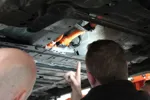Wakefield is confident that lead times will not be problem with the Golf-challenging V40.
“V40 is built in Europe, largely for the European market.
“The Chinese growth we have planned comes a bit later down the line of our strategy for 2020 and is largely driven by the investment we’re making in Chinese production facilities so that will satisfy domestic demand.
“Let’s make it clear I’m under no constraints to stop selling cars; we want to get to that 40,000 unit target as quickly as possible, I want the dealers to have a good throughput, I want to grow the vehicle parc.
I am at this point unaware of any constraints we’ve got around volume and I’m actually more interested now in going back to the factory and negotiating for more stock.”
The springboard for the ability to grow the brand and set the ambitions Wakefield has, in hand with Volvo globally, is a loan agreement with China Development Bank.
Late last year the agreement was signed with the first stage being a
€922 million loan which is to be used for the refinancing of Volvo Cars’ current loans.
It also lays the foundations for product development.
An announcement has been made regarding investment in scalable product architecture (SPA) and Volvo engine architecture (VEA).
SPA is a flexible, scalable product architecture that will cover most of Volvo’s future models, meaning lower development and parts costs to be shared by all models.
The first model to benefit is the XC90.
VEA will lead to a new range consisting solely of four-cylinder engines delivering lower fuel consumption and higher performance compared to current equivalents.
Launch activity for the next three years is quite slim (2013: V40 Cross Country and V60 plug-in diesel hybrid, 2014 XC90 and 2015 XC60 plug-in hybrid), but Wakefield is optimistic that what there is coming, combined with the investment levels in new technology, will have a significant positive impact on business.
“New product launches really kick off late 2014 with the new XC90 and continue consistently for the following few years.
And it’s important to stress the impact of what the SPA and VEA will give us that is below the surface for consumers – the product architecture which allows us to build a variety of different cars off the same platform and therefore gain an awful lot of purchasing efficiency,” Wakefield said.
“We can reduce production costs without scrimping on delivering cars known for their innovative safety and infotainment technology thanks to these two strategies.
“If we are not achieving the targets I talk about here in 2015 then I won’t have judged my performance at Volvo a success.”
Past criticism has been levelled at Volvo for its schizophrenic approach to marketing initiatives which left dealer and consumer confused about the brand’s direction.
“At two levels I’ll say that was a characteristic.
At the highest level Volvo as a brand hasn’t been consistent in its presentation,” Wakefield said.
“There was a lot of good work done around safety 10 years ago and we had some wonderful and exciting brand positioning. Since then we’ve sort of gone through this fairly inconsistent period.















Login to comment
Comments
No comments have been made yet.